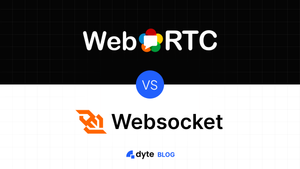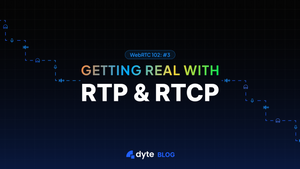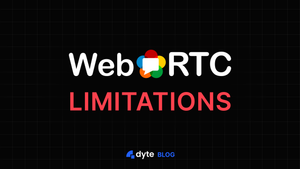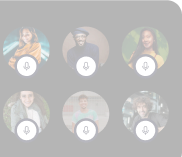While we initially hesitated to write this piece, given the stark differences between the two technologies being compared, but we realised it’s looks like it’s one of those concepts where the difference is obvious once you know it. So, let's dive in.
WebRTC and WebSocket are both powerful tools that enhance real-time communication, but they each serve unique roles and operate differently.
WebRTC is a peer-to-peer protocol designed for direct communication between browsers, making it ideal for applications involving audio and video streaming. Whereas, WebSocket is a protocol that facilitates communication between a client and a server, making it more suitable for data communication tasks.
Although they have different functions, it's important to note that both WebRTC and WebSocket have their own sets of pros and cons. Understanding these can help you make an informed decision about which technology best suits your application's needs.
For instance, if low latency and high-quality audio and video streaming are key, WebRTC would be the way to go. However, if your application requires robust data communication, WebSocket may be the better choice due to its efficiency and ability to handle larger amounts of data.
In this article, we'll delve deeper into the specific features, advantages, and potential drawbacks of both WebRTC and WebSocket. Ultimately, the choice between them will depend on your application's individual requirements. Stay tuned as we explore further.
What is WebRTC?
WebRTC, or Web Real-Time Communication, is an open-source project that enables real-time communication between web browsers and other devices. It is a collection of APIs that allow developers to create applications that can send and receive audio, video, and data in real-time. WebRTC is a powerful tool for creating applications that can be used for video conferencing, file sharing, and other real-time communication applications.
WebRTC (Web Real-Time Communication) is a technology that enables peer-to-peer connection and data transfer between two browsers or devices. It is a free, open-source project that provides browsers and mobile applications with Real-Time Communications (RTC) capabilities via simple APIs. WebRTC is designed to allow browsers and mobile applications to communicate in real-time without the need for any additional plugins or downloads.
How does WebRTC work?
WebRTC works by establishing a peer-to-peer connection between two browsers or devices. This connection is established using a signaling protocol, which is used to exchange information about the connection. Once the connection is established, data can be transferred between the two browsers or devices in real-time. This data can include audio, video, and other types of data. WebRTC also supports encryption, which ensures that the data is secure and private.
Here's a simplified explanation of how WebRTC works:
- Get User Media: The first step in a WebRTC session is accessing the device's media devices (microphone and camera). This is done using the
getUserMedia()API. - Create an RTCPeerConnection: An
RTCPeerConnectionis created. This object handles the process of setting up the direct connection between your device and another user's device. - Create an Offer: One side (the caller) starts by creating an "offer": a proposed configuration for the peer connection.
- Send the Offer Over a Signaling Channel: The offer is then sent over a signaling mechanism (not specified by WebRTC and can be any medium that can carry JSON) to the other device (the callee).
- Receive the Offer and Create an Answer: The callee receives the offer and generates an "answer", which matches the offer with compatible settings on its side.
- Send the Answer Back Over the Signaling Channel: The answer is then sent back to the caller over the signaling channel.
- Exchange ICE Candidates: Both devices exchange information about network connections in a process called ICE candidate exchange. This process involves finding the best path for the data to travel, considering firewalls and NATs.
- Connect and Start Streaming: Once this negotiation process is completed, the
RTCPeerConnectionstarts streaming audio and video between the devices.
When to use WebRTC?
WebRTC is best suited for applications that require real-time communication, such as video conferencing, file sharing, and gaming. It is also ideal for applications that require low latency, such as voice and video chat. WebRTC is also a great choice for applications that require peer-to-peer communication, such as online gaming.
WebRTC is used in various applications such as Google Meet, Discord, Facebook Messenger, and many others, providing real-time, peer-to-peer communication.
What is WebSocket?
WebSocket is a protocol that enables two-way communication between a client and a server. It is a full-duplex communication protocol, meaning that it allows for simultaneous communication in both directions. WebSocket is used to create real-time applications such as chat applications, online gaming, and video conferencing. It is an open protocol that is designed to be used in web browsers and web servers, and it is supported by all major web browsers.
How WebSocket works?
WebSockets is a communication protocol that provides full-duplex communication between a client and a server over a long-lived, persistent connection. This means data can be sent back and forth without the need for the client to request information each time.
Here is a simplified explanation of how WebSockets work:
- Opening Handshake: The process begins when the client sends a standard HTTP request to the server, asking for an upgrade to a WebSocket connection. This request includes a
Sec-WebSocket-Key, a Base64 encoded random value. - Server Response: If the server supports WebSockets and accepts the request, it will send back an HTTP response with a
Sec-WebSocket-Acceptheader, which is a hashed version of the client'sSec-WebSocket-Key. This completes the handshake and upgrades the connection from HTTP to WebSocket. - Data Transfer: Once the connection is established, the client and server can send messages back and forth in real-time. The data is sent in frames, and there's no need to reestablish the connection for each transfer.
- Closing Connection: Either the client or server can decide to close the WebSocket connection. This involves sending a close frame, and the receiver sending a close frame in return. After this, the connection is terminated.
What are the key differences between WebRTC v/s Websockets?
| WebRTC | WebSockets | |
| Protocol | Collection of protocols and APIs for peer-to-peer connections. | Protocol providing full-duplex communication over single TCP connection. |
| Use Cases | High-performance, high-quality communication of video, audio, and data (e.g., video chat). | Real-time applications like chat, multiplayer games, live document collaboration. |
| Communication Style | Peer-to-peer direct communication. | Long-lived, server-mediated connection open for sending/receiving data. |
| Data Transmission | Supports reliable and unreliable data transmission (TCP and UDP) | Supports only reliable data transmission (TCP) |
| Security | Built-in encryption (DTLS). | Secure if used over TLS-encrypted connection (wss://). |
When to use WebRTC and Websocket together?
WebRTC and Websockets serve different purposes, but they can be used together in certain scenarios to create robust real-time applications. Here's when you might want to use both:
- Signaling in Video/Audio Chat Applications: WebRTC enables real-time peer-to-peer video/audio/data communication. However, it requires a mechanism called signaling to initiate and coordinate the communication, and that's where Websockets come in. Signaling involves exchanging metadata between peers (like network information, media capabilities) before the actual peer-to-peer connection is established. Websockets, with their full-duplex communication capabilities, are often used for this purpose.
- Real-time Multiplayer Games: In a real-time multiplayer game, you might use WebRTC for direct peer-to-peer communication to ensure low latency in gameplay. However, you might also need server-mediated communication for things like game state synchronization, player matching, or anti-cheat enforcement. This is where Websockets can be useful.
- Live Broadcasting: If you're building a live broadcasting application, you might use WebRTC to capture and stream video from the broadcaster's device. On the viewer's side, however, you might use Websockets to deliver the video stream if you need to support a large number of viewers, since WebRTC's peer-to-peer connections can be resource-intensive.
Remember, the choice to use WebRTC, Websockets, or both, depends on the specific requirements of your application.
In conclusion, both WebRTC and WebSocket play pivotal roles in the realm of real-time communication on the web. While they serve different functions and have distinct strengths, they are not mutually exclusive. WebRTC excels in peer-to-peer high-quality video, audio, and data communication, making it an excellent choice for applications such as video chats or file sharing. On the other hand, WebSocket shines in scenarios requiring full-duplex, real-time communication between a client and a server, making it ideal for live chat services and multiplayer games.
In some cases, the two can even be used together to leverage the best of both worlds; WebSocket for signaling to establish connections, and WebRTC for the direct, high-performance communication thereafter.
As technology continues to evolve rapidly, the importance of real-time communication will only grow. WebRTC and WebSocket, with their unique capabilities, are sure to continue playing integral roles in this evolution. As developers, understanding these technologies and knowing when to use each can help us build applications that are more interactive, engaging, and responsive.
FAQs
Can WebRTC and WebSocket be used together?
Yes, they can be used together. For instance, WebSocket can be used for signaling to establish the peer-to-peer connection in WebRTC.
When should I use WebRTC and when should I use WebSocket?
Use WebRTC when you need high-performance, high-quality communication of video, audio, and arbitrary data, such as in a video chat application. Use WebSocket when you need real-time bi-directional communication between a client and a server, like in a live chat application or multiplayer game.
Are WebRTC and WebSocket secure?
Yes, both WebRTC and WebSocket offer secure data transmission. WebRTC has built-in encryption (DTLS), and WebSocket is secure when used over a -encrypted connection (wss:// instead of ws://).





